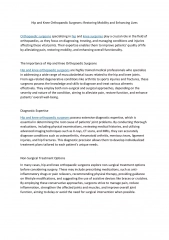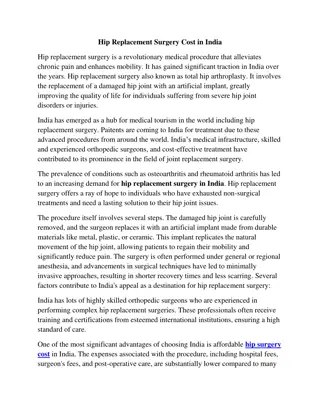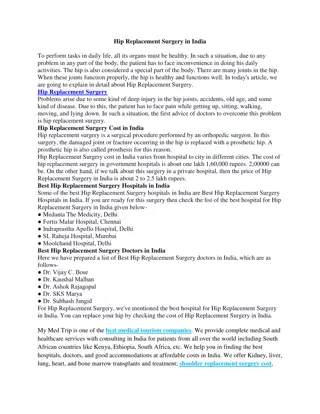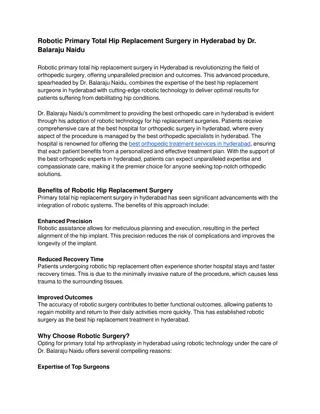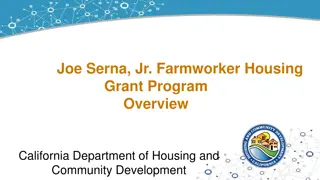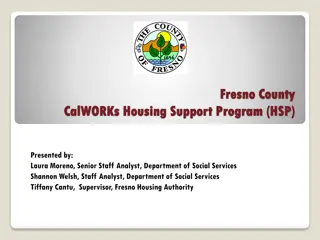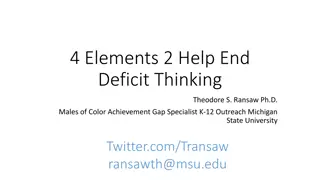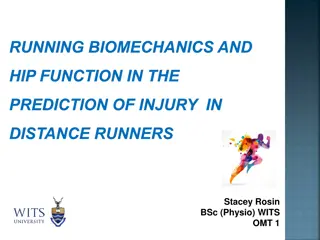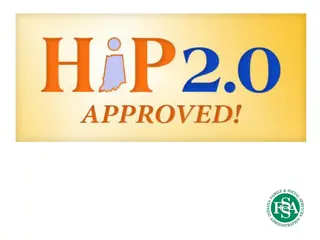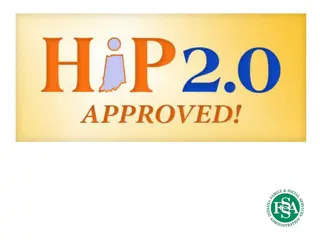Understanding the Housing Improvement Program (HIP)
The Housing Improvement Program (HIP) is a grant program aimed at providing home repair, renovation, and replacement assistance to Native American and Alaska Native individuals facing housing challenges. HIP targets the neediest individuals to eliminate substandard housing and homelessness in Indian communities, offering various types of assistance like minor repairs, renovations, replacement housing, and new housing. Eligibility criteria include being a member of a federally recognized tribe, residing in an approved tribal service area, meeting income guidelines, and having substandard or homeless housing. HIP aims to ensure every Native American and Alaska Native family has access to decent housing.
Download Presentation

Please find below an Image/Link to download the presentation.
The content on the website is provided AS IS for your information and personal use only. It may not be sold, licensed, or shared on other websites without obtaining consent from the author. Download presentation by click this link. If you encounter any issues during the download, it is possible that the publisher has removed the file from their server.
E N D
Presentation Transcript
NUTS & BOLTS - WHAT IS HIP? HIP WEBINAR WEDNESDAY, AUGUST 24, 2016 12:30PM (ET) & 3:30PM (ET) WELCOME to the 2nd WebEx HIP Training Session Series #1 & #2 Topic: HIP Overview (Nuts & Bolts)
NUTS & BOLTS - WHAT IS HIP? What Is HIP? The Housing Improvement Program is a home repair, renovation and replacement grant program administered by the Bureau of Indian Affairs (BIA) and federally-recognized Native American Tribes for Native American and Alaska Native individuals, and families, who have no immediate resources for standard housing. Why Is HIP Different? HIP is a program specifically designed to serve the neediest of the needy; to Native Americans and Alaska Natives who have substandard housing, or no housing at all, and have no other immediate source of housing assistance. HIP seeks to eliminate substandard housing and homelessness in Indian communities by helping those who need it most obtain decent, safe and sanitary housing for themselves and their families. It is the BIA s policy that every Native American and Alaska Native family should have the opportunity for a decent home and suitable living environment.
NUTS & BOLTS - WHAT IS HIP? What Does HIP Provide? Minor Repairs: Provides up to $7,500 in housing repairs for conditions that threaten the health and/or safety of the occupants, or Renovations: Provides up to $60,000 in repairs and renovations to improve the condition of a homeowner s dwelling to meet applicable building code standards, or Replacement Housing: Provides a modest replacement home if a homeowner s dwelling cannot be brought up to applicable building code standards, or New Housing: Provides a modest new home if you do not own a home, you may be eligible if you are the owner or leaseholder of land suitable for housing and the lease is for not less than 25 years at the time assistance is received. Down Payment Assistance: Provides assistance for those applying for financing from tribal, Federal, or other sources of credit, but have inadequate income or limited financial resources to meet the lenders requirements. Who Is Eligible? To be eligible for HIP assistance, you must be a member of a federally recognized Native American tribe, or be an Alaska Native; live in an approved tribal service area; have a combined household income that does not exceed 150% of the U.S. Department of Health and Human Services (DHHS) Poverty Income Guidelines (published annually in January); have present housing that is substandard or homeless, as defined by the regulations (25 CFR 256.2); meet the ownership requirements for the assistance needed, as defined by the regulations (25 CFR 256.9-.11); have no other resource for housing assistance; have never received HIP assistance for renovations, replacement housing, or down payment assistance; and have not acquired your present housing through past participation in a Federal government-sponsored housing program over the previous 20 year period. NOTE: Eligibility does not guarantee funding for services.
NUTS & BOLTS - WHAT IS HIP? How Can I Apply and What Is Required? To see if you qualify for HIP assistance, obtain an application from your local tribal housing office, BIA Agency Area Office, Regional Office, or visit the Housing Improvement Program website at: http://www.bia.gov/WhoWeAre/BIA/OIS/Human Services/HousingImprovementProgram/index.htm Send your completed application along with the following required documents to one of the above offices: Agency, Bank, Loan Institution, or Credit Union 8) Sign Privacy Act Statement 9) Signed HIP Certification 10) Approved Letter of Credit from the institution where you applied for mortgage financing (Category D only) 1) Completed Application 2) Proof of Home or Land Ownership, or Leasehold (at least 25 years) 3) Tribal Membership copies for all household members 4) Doctors Statement of disability, if applicable 5) Proof of Veteran Status (Veteran Card, Discharge papers, Veteran assistance) 6) Proof of all Household Income (W-2 s, Tax Return, SS Income, Disability, etc ) 7) Denial Letter from other assistance programs through your Housing Authority, Federal
NUTS & BOLTS - WHAT IS HIP? Need Ranking Factors & Points? HIP has six (6) Need Ranking Factors: #1 Annual Household Income (Max 25 points) * Income includes all persons living in the house * Income includes both Earned & Unearned Income * Points calculation is based on the percentage at or below 150% Federal Poverty Income Guidelines (FPIG): 0 - 25% = 25 pts 26% - 50% = 20 pts 51% - 75% = 15 pts 76% - 100% = 10 pts 101% - 125% = 5 pts 126% to 150% = 0 pts #2 Aged Person (Max 15 points) * Any one (1) person age 55 or older, and living in the house * 55 years and older = 1 point per year, over age 54 up to age 70 #3 Disabled Individual (Max 10 points) * Any one (1) disabled person living in the house (points are awarded per application, not individual) = 10 points #4 Dependent Children (Max 15 points) * Must be under the age of 18, or other age established for purposes of parental support by Tribal or State Law, and must live in the house and not be married One (1) = 3 pts Two (2) = 6 pts Three (3) = 9 pts Four (4) = 12 pts Five (5) or more = 15 pts #5 Other Conditions (Max 15 points) * If any of these conditions are present Veteran = 5 pts Homeless or Dilapidated house = 5 pts Overcrowded conditions = 5 pts #6 Approved Financing Package (Max 25 points) * For applicants seeking down payment assistance only
NUTS & BOLTS - WHAT IS HIP? What Is The HIP Income Guideline? The HIP Income Guideline is comprised of two charts, one for the lower 48 states and the other for Alaska. The income figures on the chart establish the points they will receive for the first Need Ranking Factor based on the combined Annual Household Income. Applicants with an annual income exceeding 150% of the Federal Poverty Income Guideline are not eligible for this program. How Are HIP Funds Distributed? HIP funds are distributed from Washington D.C. on the basis of the number of eligible applicants and their estimated cost of program services, submitted by each tribe annually to the Regional BIA office. Funds are then distributed to tribes through Public Law 93-638 contracts, self-determination compacts, or to Bureau of Indian Affairs offices for the delivery of program services to the most needy eligible applicants, based on their overall ranking and points standing within their Region. What Is The HIP Application Process & Funding Timeline? HIP applications are accepted throughout the year; however, the deadline for each tribes submission of their eligibility list (Tribal Work Plan), to the region office, is September 30th. Typically funds are not distributed to the regional offices until approximately April/May*, and then not received at the tribal level until May/June*. Applicants and tribes will not know if they will be receiving HIP funds until after funds have been distributed to the regional office. *Timing will be dependent on the passing of appropriations.
NUTS & BOLTS - WHAT IS HIP? Federal Poverty Income Guideline? Below is a snapshot of the Table used for establishment of the applicants Annual Household Income Ranking Factor. FACTOR NO. 1 - HIP ELIGIBILITY/SELECTION CRITERIA @ 150% INCOME GUIDELINE POINT SCHEDULE FOR ALL STATES EXCEPT ALASKA & HAWAII 101% to 125% of PG 5 POINTS 125% to 150% of PG 0 POINTS FAMILY SIZE 0% to 25% of PG 25 POINTS 26% to 50% of PG 20 POINTS 51% to 75% of PG 15 POINTS 76% to 100 of PG 10 POINTS OVER 150% of FPIG INELIGIBLE 1 0TO 2,943 2,944 TO 5,885 5,886 TO 8,828 8,829TO 11,770 11,771TO 14,713 14,714TO 17,655 17,656 & HIGHER 2 0TO 3,983 3,984 TO 7,965 7,966 TO 11,948 11,949TO 15,930 15,931TO 19,913 19,914TO 23,895 23,896 & HIGHER 3 0TO 5,023 5,024 TO 10,045 10,046 TO 15,068 15,069TO 20,090 20,091TO 25,113 25,114TO 30,135 30,136 & HIGHER 4 0TO 6,063 6,064 TO 12,125 12,126 TO 18,188 18,189TO 24,250 24,251TO 30,313 30,314TO 36,375 36,376 & HIGHER 5 0TO 7,103 7,104 TO 14,205 14,206 TO 21,308 21,309TO 28,410 28,411TO 35,513 35,514TO 42,615 42,616 & HIGHER 6 0TO 8,143 8,144 TO 16,285 16,286 TO 24,428 24,429TO 32,570 32,571TO 40,713 40,714TO 48,855 48,856 & HIGHER 7 0TO 9,183 9,184 TO 18,365 18,366 TO 27,548 27,549TO 36,730 36,731TO 45,913 45,914TO 55,095 55,096 & HIGHER 8 0TO 10,223 10,224 TO 20,445 20,446 TO 30,668 30,669TO 40,890 40,891TO 51,113 51,114TO 61,335 61,336 & HIGHER 9 0TO 11,263 11,264 TO 22,525 22,526 TO 33,788 33,789TO 45,050 45,051TO 56,313 56,314TO 67,575 67,576 & HIGHER 10 0TO 12,303 12,304 TO 24,605 24,606 TO 36,908 36,909TO 49,210 49,211TO 61,513 61,514TO 73,815 73,816 & HIGHER
NUTS & BOLTS - WHAT IS HIP? ARE THERE ANY QUESTIONS ???


